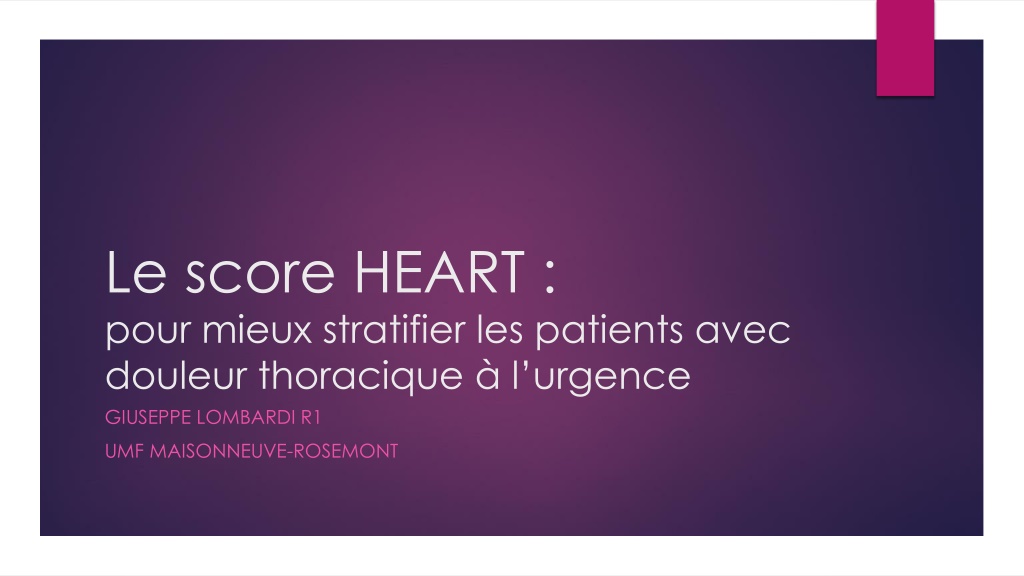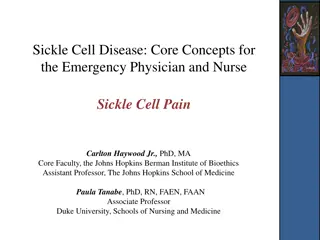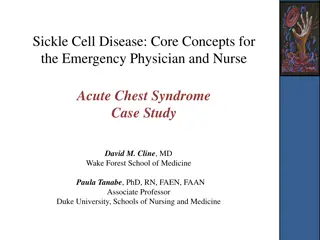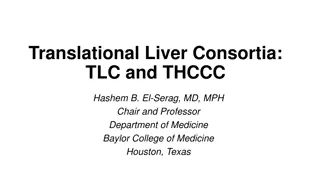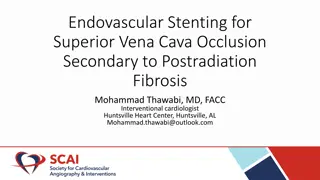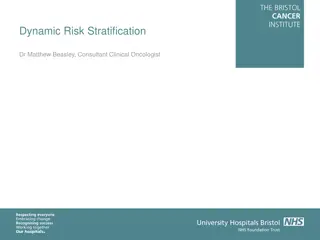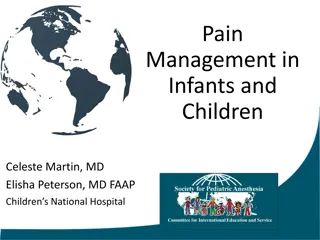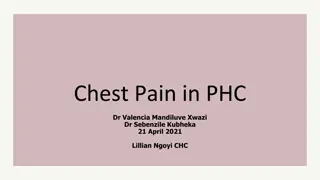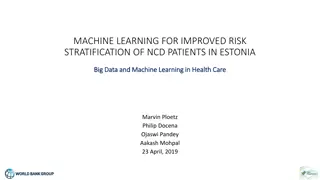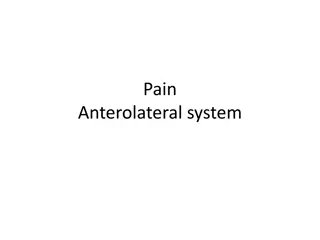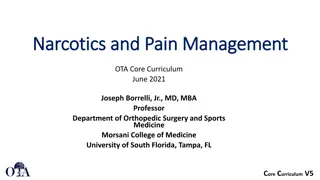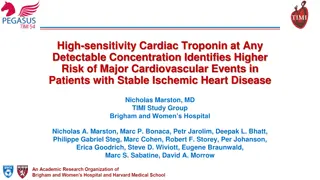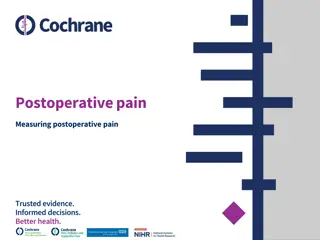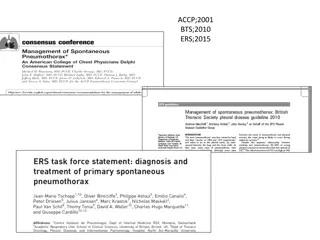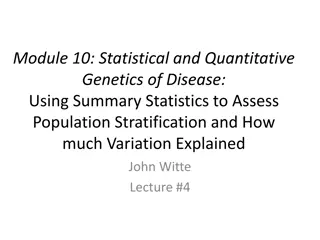Understanding the HEART Score for Risk Stratification in Patients with Chest Pain
The HEART score is a valuable tool for stratifying patients presenting with chest pain in the emergency department. It helps in distinguishing between low, intermediate, and high-risk individuals and guides further management decisions. By incorporating factors like history, ECG findings, age, risk factors, and troponin levels, the HEART score aids in determining the need for further testing or intervention, leading to better patient outcomes.
Download Presentation

Please find below an Image/Link to download the presentation.
The content on the website is provided AS IS for your information and personal use only. It may not be sold, licensed, or shared on other websites without obtaining consent from the author. Download presentation by click this link. If you encounter any issues during the download, it is possible that the publisher has removed the file from their server.
E N D
Presentation Transcript
Le score HEART : pour mieux stratifier les patients avec douleur thoracique l urgence GIUSEPPE LOMBARDI R1 UMF MAISONNEUVE-ROSEMONT
Vous tes lurgence F 56 ans HTA, DB DRS atypique il y a 1 heure, r solue ECG N troponine N Docteur, est-ce que je peux partir?
Que faites vous avant de lui donner cong ? A) troponine dans 3 heures B) preuve d effort l h pital C) consultation en cardiologie D) rien : cong et preuve d effort en externe STRATIFICATION DE RISQUE
Un dilemme courant lurgence < 20% des DRS l urgence sont des SCA 1 Mais : 5% des SCA seront cong di s 2 Pouvons nous faire mieux? AHA (2016) 3 : l approche traditionnelle (histoire, examen, facteurs de risque) est inad quate pour diff rencier les causes de douleur thoracique 1. Pope 2000 2. Christenson 2004 3. Hollander 2016 Utiliser un algorithme d cisionnel
Introduction Un bon algorithme d cisionnel: Tr s peu de faux n gatifs (VPN >98%)1,2 Minimise les faux positifs (taux de cong >30%) 3 En connaissez-vous? TIMI GRACE et plusieurs autres 1. Mahler 2015 2. Kline 2005 3. Carlton 2015
Score HEART comme lApgar! H E A R T facteurs de risque histoire ECG ge troponine 0 points non-cardiaque normal <45 ans 0 N 1 points atypique 45-65 ans 1 2 1 3 fois N non-sp cifiques 3 ou 2 points typique ST >65 ans > 3 fois N MCAS connue risque faible 0 3 adapt de Six 2008 risque interm diaire 4 7 risque lev 8 10
Lalgorithme HEART adapt de Mahler 2015
Objectif Est-ce qu un faible risque HEART est : assez sensible pour exclure un v nement court terme chez les patients avec DRS l urgence? sup rieur au jugement clinique et les autres scores?
Mthodes Revue de la litt rature Mots cl s sur Medline/EMBASE: heart score OU heart pathway ET chest pain OU acute coronary syndrome Mots cl s MeSH/Emtree Recherche bibliographique
Mthodes Crit res d inclusion : tudes observationnelles ou exp rimentales Douleur thoracique l urgence Calcul du score HEART Bas risque 3 Calcul de taux d v nement cardiaque et VPN
Mthodes Crit res d exclusion : Revues de la litt rature Non-disponible / langue trang re Milieu pr -hospitalier / triage Bas risque 2 ou 4
valuation mthodologique Haute qualit = 7 sur 10 tude de cohorte : Objectif clair Recrutement de la cohorte Mesure de l exposition Inspir par la grille du CASP (2017) Mesure de l issue Facteurs confondants Suivi Pr cision des r sultats Applicabilit des r sultats Concordance avec la litt rature Implications la pratique
valuation mthodologique Haute qualit = 7 sur 10 tude randomis e : Objectif clair Randomisation Suivi Inspir par la grille du CASP (2017) Aveuglement Similarit des groupes Contr le facteurs confondants Pr cision des r sultats Applicabilit des r sultats R sultats cliniquement importants B n fices vs risques/couts
Rsultats 24 tudes 3 randomis es, 21 observationnelles 7 avec troponines s ri es (algorithme HEART) taux d v nement h t rog ne (1% 36%) suivi de 30 jours 3 mois 17 de bonne qualit
tudes : score HEART (une troponine) % bas risque 39% 36% 32% 37% 51% 56% 28% 16% 19% 60% 60% 34% 33% 34% 11% 33% 32% tude Ann e Type N Taux d'EICM VPN Qualit Poldervaart Backus Carlton Santi Sun Leite Six Sakamoto Jain Melki Marcoon Backus Patnaik Bodapati Bolvardi Visser Six HEART = histoire, ECG, ge, facteurs de risque, troponine; EICM = v nement ind sirable cardiaque majeur 2017 2013 2015 2016 2016 2015 2013 2016 2016 2013 2013 2010 2017 2016 2016 2015 2008 Randomis e Prospective R trospective R trospective R trospective R trospective R trospective Prospective R trospective R trospective Prospective R trospective R trospective R trospective Prospective Prospective R trospective 3648 2388 959 1378 8255 233 2906 604 947 410 8815 880 299 678 110 255 122 19% 17% 8% 15% 6% 9% 13% 36% 19% 7% 8% 18% 6% 21% 24% 29% 24% 98.0% 98.3% 98.3% 100% 98.2% 97.9% 98.3% 98.0% 99.4% 99.6% 96.5% 99% 100% 99% 100% 94% 97.5% 10 10 9 8 8 8 8 7 7 7 7 7 6 6 5 5 5
tudes : algorithme HEART (troponines s ri es) Intervalle des troponines % bas risque tude Ann e Type N Taux d'EICM VPN Qualit McCord 2017 R trospective 1282 1 heure 17% 99.8% 40% 9 Mahler 2013 R trospective 991 3 heures 22% 99% 20% 9 Poldervaart 2016 Randomis e 1748 n/a 19% 98.2% 41% 8 Mahler 2015 Randomis e 282 3 heures 6% 100% 47% 8 Willems 2014 Prospective 89 4-6 heures 10% 100% 46% 7 Jellema 2014 Prospective 437 4-6 heures 30% 95.4% 20% 5 Mahler 2011 Prospective 1070 4-6 heures 1% 100% 82% 4 HEART = histoire, ECG, ge, facteurs de risque, troponine; EICM = v nement ind sirable cardiaque majeur
tudes randomises tude Ann e Type N Taux d'EICM VPN % bas risque Qualit Poldervaart 2017 Randomis e 3648 19% 98.0% 39% 10 Poldervaart 2016 Randomis e 1748 19% 98.2% 41% 8 Mahler 2015 Randomis e 282 6% 100% 47% 8 HEART = histoire, ECG, ge, facteurs de risque, troponine; EICM = v nement ind sirable cardiaque majeur
HEART vs jugement clinique Sup rieur ou quivalent au jugement clinique (5 tudes) 2 tudes randomis es : aussi s curitaire, plus de patients identifi s 1 tude r trospective : sup rieur au jugement (VPN 99% vs 96%) 2 tudes de cohorte : sup rieur, mais pas statistiquement significatif
HEART vs TIMI/GRACE Sup rieur au TIMI (7 tudes) VPN sup rieure dans 6 tudes L g rement inf rieure dans 1 tude (98.3% vs 98.7%) Identifie plus de patients au cong dans 6 tudes quivalent dans 1 tude (31.6% vs 32.1%) Sup rieur au GRACE (4 tudes) VPN et taux de cong sup rieur
Discussion Faible risque HEART = faible risque d v nement Troponines s ri es = meilleure sensibilit Trois tudes randomis es de bonne qualit Appuient la litt rature observationnelle
Avantages du HEART Facile utiliser Plus objectif que le jugement clinique Potentiel conomique Moins d admissions inutiles Moins de faux positifs
Rduction des admissions tude de Mahler : 20% de patients admis malgr bas risque Aucun v nement additionnel pr venu tude de Jain : 31% des patients bas risque ont eu preuve d effort 10% des preuves = positives La moiti : coro n gative! HEART aurait permis de diminuer les preuves de 83%
Limitations tudes observationnelles = biais Mais: tudes randomis es de bonne qualit Subjectivit du score ( histoire ) Ne pas oublier les diagnostics non-cardiaques SCA sans douleur thoracique? Ne devrait pas remplacer le jugement du clinicien!
Conclusion Le score HEART permet: Une meilleure stratification de risque pour patients avec douleur thoracique vs le jugement clinique vs les autres scores (TIMI/GRACE) D tablir un risque de SCA objectif d cision partag e entre clinicien et patient sur cong pr coce am liorer la communication entre professionnels
Rfrences 1.Pope, J.H., et al., Missed diagnoses of acute cardiac ischemia in the emergency department. N Engl J Med, 2000. 342(16): p. 1163-70. 2.Hermann, L.K., et al., The limited utility of routine cardiac stress testing in emergency department chest pain patients younger than 40 years. Ann Emerg Med, 2009. 54(1): p. 12-6. 3.Christenson, J., et al., Safety and efficiency of emergency department assessment of chest discomfort. CMAJ, 2004. 170(12): p. 1803-7. 4.Hollander, J.E., M. Than, and C. Mueller, State-of-the-Art Evaluation of Emergency Department Patients Presenting With Potential Acute Coronary Syndromes. Circulation, 2016. 134(7): p. 547-64. 5.Welsford, M., et al., Part 5: Acute Coronary Syndromes: 2015 International Consensus on Cardiopulmonary Resuscitation and Emergency Cardiovascular Care Science With Treatment Recommendations. Circulation, 2015. 132(16 Suppl 1): p. S146-76. 6.Apgar, V., A proposal for a new method of evaluation of the newborn infant. Curr Res Anesth Analg, 1953. 32(4): p. 260-7. 7.Six, A.J., B.E. Backus, and J.C. Kelder, Chest pain in the emergency room: value of the HEART score. Neth Heart J, 2008. 16(6): p. 191-6. 8.Poldervaart, J.M., et al., Comparison of the GRACE, HEART and TIMI score to predict major adverse cardiac events in chest pain patients at the emergency department. Int J Cardiol, 2017. 227: p. 656-661. 9.Mahler, S.A., et al., The HEART Pathway randomized trial: identifying emergency department patients with acute chest pain for early discharge. Circ Cardiovasc Qual Outcomes, 2015. 8(2): p. 195-203. 10. Than, M., et al., What is an acceptable risk of major adverse cardiac event in chest pain patients soon after discharge from the Emergency Department?: a clinical survey. Int J Cardiol, 2013. 166(3): p. 752-4.
Rfrences 11. Carlton, E.W., A. Khattab, and K. Greaves, Identifying Patients Suitable for Discharge After a Single-Presentation High-Sensitivity Troponin Result: A Comparison of Five Established Risk Scores and Two High-Sensitivity Assays. Ann Emerg Med, 2015. 66(6): p. 635-645 e1. 12. Mitchell, A.M., et al., Prospective multicenter study of quantitative pretest probability assessment to exclude acute coronary syndrome for patients evaluated in emergency department chest pain units. Ann Emerg Med, 2006. 47(5): p. 447. 13. Kline, J.A., et al., Pretest probability assessment derived from attribute matching. BMC Med Inform Decis Mak, 2005. 5: p. 26. 14. CASP Randomised Controlled Trial Checklist. 2017; Available from: http://www.casp-uk.net/. 15. CASP Cohort Study Checklist. 2017; Available from: http://www.casp-uk.net/. 16. Patnaik, S., et al., Clinical utility of the HEART score in patients admitted with chest pain to an inner-city hospital in the USA. Coron Artery Dis, 2017. 17. Sakamoto, J.T., et al., Comparing HEART, TIMI, and GRACE scores for prediction of 30-day major adverse cardiac events in high acuity chest pain patients in the emergency department. Int J Cardiol, 2016. 221: p. 759-64. 18. Jain, T., et al., Short- and Long-Term Prognostic Utility of the HEART Score in Patients Evaluated in the Emergency Department for Possible Acute Coronary Syndrome. Crit Pathw Cardiol, 2016. 15(2): p. 40-5. 19. Sun, B.C., et al., Comparison of the HEART and TIMI Risk Scores for Suspected Acute Coronary Syndrome in the Emergency Department. Crit Pathw Cardiol, 2016. 15(1): p. 1-5. 20. Bodapati, S.N., et al., Chest pain risk assessment in Indigenous and non-Indigenous Australians using HEART Score. Emerg Med Australas, 2016. 28(2): p. 138-44.
Rfrences 21. Melki, D. and T. Jernberg, HEART score: a simple and useful tool that may lower the proportion of chest pain patients who are admitted. Crit Pathw Cardiol, 2013. 12(3): p. 127-31. 22. Six, A.J., et al., The HEART score for the assessment of patients with chest pain in the emergency department: a multinational validation study. Crit Pathw Cardiol, 2013. 12(3): p. 121-6. 23. Backus, B.E., et al., A prospective validation of the HEART score for chest pain patients at the emergency department. Int J Cardiol, 2013. 168(3): p. 2153-8. 24. Backus, B.E., et al., Chest pain in the emergency room: a multicenter validation of the HEART Score. Crit Pathw Cardiol, 2010. 9(3): p. 164-9. 25. Santi, L., et al., The HEART score with high-sensitive troponin T at presentation: ruling out patients with chest pain in the emergency room. Intern Emerg Med, 2017. 12(3): p. 357-364. 26. Poldervaart, J.M., et al., Effect of Using the HEART Score in Patients With Chest Pain in the Emergency Department: A Stepped-Wedge, Cluster Randomized Trial. Ann Intern Med, 2017. 27. Bolvardi, Evaluation efficacy of HEART score in prediction of major advanced cardiac events in patients with chest pain. Biosciences Biotechnology Research Asia, 2016. 13(2): p. 999-1005. 28. McCord, J., et al., Prognostic Utility of a Modified HEART Score in Chest Pain Patients in the Emergency Department. Circ Cardiovasc Qual Outcomes, 2017. 10(2). 29. Mahler, S.A., et al., Identifying patients for early discharge: performance of decision rules among patients with acute chest pain. Int J Cardiol, 2013. 168(2): p. 795-802. 30. Mahler, S.A., et al., Can the HEART score safely reduce stress testing and cardiac imaging in patients at low risk for major adverse cardiac events? Crit Pathw Cardiol, 2011. 10(3): p. 128-33.
Rfrences 31. Willems, M.N., et al., Addition of heart score to high-sensitivity troponin T versus conventional troponin T in risk stratification of patients with chest pain at the coronary emergency rooms. Neth Heart J, 2014. 22(12): p. 552-6. 32. Visser, A., et al., HEART score and clinical gestalt have similar diagnostic accuracy for diagnosing ACS in an unselected population of patients with chest pain presenting in the ED. Emerg Med J, 2015. 32(8): p. 595-600. 33. Jellema, L.J., et al., The value of clinical and laboratory diagnostics for chest pain patients at the emergency department. Clin Chem Lab Med, 2014. 52(2): p. 259-66. 34. Marcoon, S., et al., HEART score to further risk stratify patients with low TIMI scores. Crit Pathw Cardiol, 2013. 12(1): p. 1-5. 35. Leite, L., et al., Chest pain in the emergency department: risk stratification with Manchester triage system and HEART score. BMC Cardiovasc Disord, 2015. 15: p. 48. 36. Mahler, S.A., et al., Adherence to an Accelerated Diagnostic Protocol for Chest Pain: Secondary Analysis of the HEART Pathway Randomized Trial. Acad Emerg Med, 2016. 23(1): p. 70-7. 37. Body, R., et al., Can emergency physicians 'rule in' and 'rule out' acute myocardial infarction with clinical judgement? Emerg Med J, 2014. 31(11): p. 872-6. 38. Riley, R.F., et al., Cost analysis of the History, ECG, Age, Risk factors, and initial Troponin (HEART) Pathway randomized control trial. Am J Emerg Med, 2017. 35(1): p. 77- 81. 39. Six, A.J., et al., Consumption of diagnostic procedures and other cardiology care in chest pain patients after presentation at the emergency department. Neth Heart J, 2012. 20(12): p. 499-504. 40. Nieuwets, A., et al., Medical consumption compared for TIMI and HEART score in chest pain patients at the emergency department: a retrospective cost analysis. BMJ Open, 2016. 6(6): p. e010694. 41. Backus, B.E., et al., Prognostic Factors in Chest Pain Patients: A Quantitative Analysis of the HEART Score. Crit Pathw Cardiol, 2016. 15(2): p. 50-5.
Remerciements Mme Marie Authier
